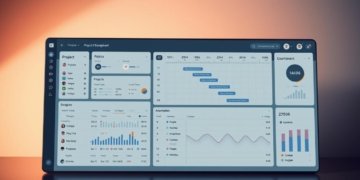Can one platform really replace all your tech tools? For businesses stuck with many tools, HubSpotoffers a solution. Launched in 2005, it started as a HubSpot CRM for marketers. Now, it leads the marketing automation market with over 29% share, beating its top competitors.
HubSpotis more than a tool; it’s a unified system. It connects marketing, sales, service, content, and operations in one place. This means you can track customer interactions, automate workflows, and make data-driven decisions.
Imagine having one platform instead of many apps. HubSpot’s five core hubs—Marketing, Sales, Service, CMS, and Operations—work together. Even small teams can use it easily, thanks to drag-and-drop website builders and pre-built integrations.
So, how does one platform handle so much? This guide explores HubSpotgrowth from a CRM to a complete business solution. We’ll show how it simplifies processes, from creating content to analyzing data in real-time. It replaces the need to guess when using many systems.
Key Takeaways
- HubSpot holds 29% market share, leading competitors in marketing automation.
- Its five hubs integrate CRM, marketing, sales, service, and CMS into one system.
- No coding required—small teams can use it fully without developer help.
- Free trials and waived onboarding fees with partners lower entry barriers.
- Automated workflows and real-time dashboards boost ROI tracking and team collaboration.
What is HubSpot?
HubSpotis a platform that helps businesses with marketing, sales, and customer service. It was created in 2005 for marketers. Now, it’s a complete tool for all stages of customer interaction.
Overview of HubSpot’s Features
HubSpot has five main areas that work together. The Marketing Hub uses AI for content and campaigns. It also tests and personalizes marketing.
The Sales Hub automates follow-ups and tracks deals. It uses AI to find the best leads. The Service Hub helps solve customer problems quickly with AI.
The CMS Hub makes building websites easy. The Operations Hub keeps data up-to-date for teams. HubSpot also uses Breeze Intelligence to improve targeting.
Benefits of Using HubSpot
HubSpot gives a clear view of customer interactions. It tracks emails, calls, and website visits. It also has over 1,000 integrations to help teams work together.
AI tools like Breeze Copilot save time by automating tasks. HubSpot has affordable plans for small teams. This helps businesses grow without losing quality or speed.
Setting Up Your HubSpot Account
Starting with HubSpot CRM is easy with clear steps. First, pick a plan, free or paid, and fill in your business info. Make sure to turn on two-factor authentication for better security. Note, single sign-on is only for Enterprise accounts.
You can set up custom user permissions to control who sees what. Adjusting time zones and languages is also possible in account settings.
Once set up, explore the dashboard for key functions. It has a menu for CRM modules, an activity feed, and alerts for new interactions. You’ll find sections for contacts, deals, and pipelines, which are vital for sales and marketing.
The dashboard also shows analytics dashboards. These help track campaign performance and customer trends.
To get the most out of CRM, integrate your email, import contacts, and install website tracking code. Define deal stages and set up lead ads to find new opportunities. Invite your team to start working together. HubSpot CRM’s dashboard makes managing everything easy, keeping all data in one place for analysis.
Understanding HubSpot’s Pricing Structure
HubSpot pricing has changed to a seat-based model. This replaces the old tiered plans. The free CRM lets you have unlimited contacts and basic marketing tools, great for startups.
Paid plans grow with your business. They offer core seats for active users and free view-only access for others. This way, you don’t pay for features you don’t use.
Free vs. Paid Plans
The free plan gives you access to core CRM tools but limits marketing contacts to 1,000. Paid plans unlock more advanced features like AI content suggestions and automation. Starter plans start at $20/month for Marketing Hub, with 2,000 contacts.
Professional tiers start at $100/month per seat. Enterprise plans offer custom pricing for big teams.
Key Features of Each Plan
Marketing Hub Professional ($890/month) includes a $3,000 onboarding fee and 10,000 contact capacity. Sales Hub Starter costs $20/month per seat, with Pro plans needing annual commitments. Enterprise tiers like Service Hub Enterprise ($150/month per seat) add dedicated support and custom reporting.
Bundled packages save money for users of multiple Hubs. View-only seats reduce costs for non-editors. All tiers include AI tools like COS and predictive analytics, helping any budget.
Exploring HubSpot’s Tools
HubSpot’s platform has three main toolsets. They help align marketing, sales, and service efforts. Each tool works with CRM data to give a unified customer experience. They make workflows easier across different departments.
Marketing Hub Overview
The Marketing Hub has AI tools for creating content, SEO analyzers, and email builders. Users can make landing pages, run ads, and track how well campaigns do in real time. It also has a form builder and CTAs to catch leads better.
SEO suggestions help make websites more visible. Built-in analytics show which campaigns work best. This keeps marketing efforts focused on what works.
Sales Hub Overview
Sales Hub makes outreach easier with tools like meeting schedulers and battle cards. It shows how deals are doing with pipelines and tracks email opens. AI scores leads to find the most valuable ones.
CRM syncs keep all interactions in one place. Automated sequences follow up with leads without needing to do it manually.
Service Hub Overview
Service Hub puts customer service in one place with ticketing systems and live chat. Chatbots answer simple questions, and knowledge bases cut down on repeat requests. Feedback surveys and satisfaction tracking tools check how well service is doing.
All interactions are shared across teams. This ensures customers get the same support everywhere.
Configuring Your HubSpot Settings
Getting the most out of HubSpot starts with setting up the basics. You can customize your dashboard and control who can see what. The latest updates make it easier to navigate and use.
Customizing Your Dashboard
Make your workspace your own by moving around widgets. Add reports to track important numbers and set alerts for key tasks. You can also adjust how often you get emails to stay updated without feeling overwhelmed.
HubSpot tools help you create views for different roles. For example, sales teams can focus on deals, while marketing teams can watch campaign results.
Managing User Permissions
Give users roles like admin, regular user, or reporting-only to control what they see. Turn on two-factor authentication and check user emails to keep accounts safe. You can also organize teams by department and follow GDPR rules for EU data.
Manage contact details and stages to keep HubSpot CRM up to date. Check permissions often to make sure everyone has the right access.
Utilizing HubSpot CRM
HubSpot CRM is at the heart of all HubSpot tools. It’s a central place to manage customer data. The free version has live chat, lead capture forms, and tools to track leads.
Users can create custom properties to organize contact details. They can also link contacts to companies by shared domains.
Adding Contacts and Companies
Adding contacts is easy, either one by one or in bulk from spreadsheets. Custom properties help teams sort data like job titles or purchase history. Companies are linked automatically when contacts share a domain.
HubSpot Academy courses help with setup. The Knowledge Base has over 100 articles on using these features well.
Tracking Interactions
Every email, call, or website visit is logged in HubSpot CRM. The timeline view shows all interactions in order. This includes email opens, meeting notes, and form submissions.
Teams can add notes for offline talks. This ensures no important details are missed. This data helps in sales pipelines, showing how many emails and meetings each rep has.
Implementing Inbound Marketing with HubSpot
HubSpot marketing tools help businesses use inbound strategies. They make creating and optimizing content easier. Start by using the platform’s tools to make engaging materials that attract people.
The blog platform and landing page builder make it easy to create professional content. You can use drag-and-drop editors. There are pre-designed templates and options to personalize your campaigns, making sure they match your brand goals.
Content Creation Tools
HubSpot marketing has tools for managing blogs, landing pages, and CTAs. The editor lets teams build responsive pages without needing to code. It also helps with content strategy by organizing articles based on audience interests.
For example, marketers can use HubSpot’s SEO tool to find keywords like “HubSpot marketing”. This helps structure content to improve search visibility.
SEO and Analytics Features
HubSpot marketing analytics track important metrics like page performance and conversion rates. The SEO suite offers tips for on-page optimization. Real-time analytics show how content is doing.
For instance, data shows timely follow-ups can increase conversion rates by 21x. This highlights how using these tools can improve lead nurturing. By keeping an eye on metrics, campaigns can stay on track to attract and engage audiences.
Creating Effective Email Campaigns
Email marketing is key in today’s HubSpot marketing plans. HubSpot’s tools make creating emails easy with features that increase engagement. Use the drag-and-drop editor to design templates without coding.
Choose from pre-made layouts or customize with your own fonts, colors, and CTAs. Make messages personal with data like location or purchase history. This makes your content feel more tailored.
Designing Your First Email
HubSpot’s HubSpot tools help you pick email types like automated workflows or RSS-driven newsletters. Make sure emails are under 102KB to avoid Gmail clipping. Use A/B testing to compare subject lines or send times.
Tests can run up to 100 hours and need at least 1,000 recipients for good results. Exclude unengaged contacts to improve deliverability and focus on active audiences.
Analyzing Email Performance
Track metrics like open rates and click-through rates in the analytics dashboard. If engagement is low, try adjusting subject lines or segments based on buyer behavior. Segment lists using data like past purchases to refine targeting.
Regularly remove inactive contacts to boost deliverability and ROI. Use these insights to improve future campaigns and meet broader HubSpot marketing goals.
Integrating HubSpot with Other Software
HubSpot integration makes your tech stack work better together. It connects tools into one system. The Operations Hub makes data flow smoothly, turning different data into useful insights.
Businesses get automation, updates in real-time, and see everything across platforms. This is thanks to smart connections.
Popular Integrations to Consider
Integrations like Slack for teamwork, Zoom for meetings, and Shopify for online stores are common. HubSpot’s App Marketplace has over 200 certified apps. These apps improve CRM, marketing, or sales workflows.
Bi-directional syncs let data move both ways. The Operations Hub also turns data from spreadsheets, PDFs, or old systems into HubSpot’s databases.
App Marketplace Access or super admin rights are needed to connect apps. Sync health dashboards show the status of records. Initial data transfers might take days for big datasets.
But, updates happen within 10 minutes after setup. Email alerts let users know when syncs are done, making transitions smooth.
API Usage and Custom Integrations
Advanced users use HubSpot’s API for custom integrations. Developers can automate complex tasks, like syncing CRM data with other systems. The Operations Hub’s sync engine handles data flows between HubSpot and third-party apps.
APIs also let you connect multiple instances, like linking many Shopify stores to one HubSpot account. Data integrity tools avoid duplicates by matching email addresses or unique IDs.
Developers can start workflows based on sync events, like sending an email alert for a new Shopify order. HubSpot’s API documentation helps teams build secure, scalable integrations that meet specific business needs.
Tips for Maximizing HubSpot’s Potential
HubSpot’s tools have a lot to offer, but success takes smart strategies and ongoing learning. Start with basic practices to lay a solid foundation for growth.
Best Practices for Beginners
Begin with automation to make workflows smoother. Use HubSpot automation workflows to start actions like email sequences when leads meet certain criteria. Set up sequences to nurture prospects with timed emails.
Clean data is key: schedule quarterly audits to remove duplicates and use HubSpot’s property validation to avoid errors. Focus on core tools like CRM first before adding advanced features. Avoid making setups too complicated early on.
Resources for Continued Learning
HubSpot Academy offers free courses and certifications in marketing, sales, and service. Join the HubSpot Community for case studies, expert advice, and feedback channels. Check out official blogs and forums for the latest best practices.
Use HubSpot tools like integrations (over 1,000 available) to expand functionality. YouTube channels and third-party blogs offer extra tutorials for advanced automation and CRM strategies.
FAQ
What is HubSpot?
HubSpot is a business platform that does it all. It combines marketing, sales, customer service, and more into one system. It’s used by many businesses because it’s so versatile.
What features are included in HubSpot’s Marketing Hub?
The Marketing Hub has tools for email, social media, content, landing pages, and SEO. These tools help you run marketing campaigns and track how well they do.
How do I sign up for HubSpot?
Visit the HubSpot website to sign up. You can pick from a free version or paid plans. Just give some basic info to start.
What is the difference between HubSpot’s free and paid plans?
The free version has basic CRM and marketing tools. Paid plans offer more features like automation and analytics. These are good for bigger businesses.
Can HubSpot tools integrate with other software?
Yes, HubSpot works with many tools like Slack and Shopify. You can find integrations in the App Marketplace or use the API for custom ones.
What are some best practices for using HubSpot effectively?
Start by managing your data well. Don’t get too complicated with automation at first. Use a phased approach and clean up your data regularly.
How can I customize the HubSpot dashboard?
Customize your dashboard by adding or removing components. Set up custom reports and adjust notifications to fit your needs.
How does HubSpot support inbound marketing?
HubSpot helps with inbound marketing through its content tools and SEO features. This lets businesses create and optimize content to engage customers.
What resources can help me learn more about HubSpot?
HubSpot Academy has certification programs. You can also use the community forums and knowledge base. YouTube and blogs offer more tips and tricks.














